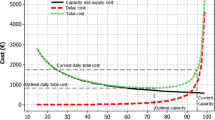Abstract
A nonpreemptive queuing system based upon operations management theory is used to evaluate expected steady state wait periods for traditional and distributed CT scheduling models. Both models are constructed using two classes of patient service—emergent and nonemergent. The former model uses only one point of service per scanner while the latter employs multiple points of service in order to accomplish all of the functions necessary to complete a CT scan. Sample data are drawn from a tertiary care hospital-based system using a traditional service model. Comparison of a traditional and distributed service system, each with emergent and nonemergent service classes, shows that breaking as many activities as possible out of the scanner should provide substantial improvements in cost efficiency and service for patients having CT scans. Nonemergent patients may experience as much as an 89% reduction in steady-state wait times while emergent patients may experience as much as a 59% reduction in wait times. The cost efficiencies recognized either through increased scanner utilization or reduced scanner needs, even with only modest improvements, should more than offset any additional personnel needed to implement a distributed model. Proper implementation of a distributed scheduling model for CT scanning can provide substantial cost efficiencies and improvements in service for both nonemergent and emergent CT scans.
Similar content being viewed by others
REFERENCES
Federal Express, Fortune, July 28, 1980, p. 10.
Kleinfield, N.R., ‘Conquering Those Killer Queues,’ The New York Times, September 25, 1988.
Winter, J., Efficiency of utilization of a computed tomography scanner. AJR 131:89–93, 1978.
Evens, R.G., and Jost, R.G., Economic analysis of body computed tomography units including data on utilization. Radiology 127:151–157, 1978.
Evens, R.G., and Jost, R.G., Economic analysis of computed tomography units. AJR 127:191–198, 1976.
Seltzer, S.E., Saini, S., Bramson, R.T., Kelly, P., and Levine, L., Can academic radiology departments become more efficient and cost less? Radiology 209:405–410, 1998.
Hillier, F.S., and Lieberman, G.J., Introduction to Operations Research, McGraw Hill, 6th Edition, 1995.
Conover, W.J., Practical Nonparametric Statistics. Wiley, 3rd Edition, 1999, p. 430.
Maister, D.H., The Psychology of Waiting Lines, The Service Encounter, (J.A. Czepiel, M.R. Solomon, and C.F. Surprenant, eds.), Lexington Books, 1985.
Rhea, J.T., Thrall, J.H., Saini, S., and Sumner, J., Improving the efficiency and service of computed tomographic scanning. Acad. Radiol. 1:164–170, 1994.
Author information
Authors and Affiliations
Rights and permissions
About this article
Cite this article
Reinus, W.R., Enyan, A., Flanagan, P. et al. A Proposed Scheduling Model To Improve Use of Computed Tomography Facilities. Journal of Medical Systems 24, 61–76 (2000). https://doi.org/10.1023/A:1005512729184
Issue Date:
DOI: https://doi.org/10.1023/A:1005512729184




